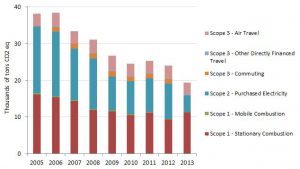What does neutrality mean? Dramatic improvements in efficiency, and finding alternative energy sources, including energy conservation. If we do it right, the co-benefits of climate action include saving money in the long run, building knowledge about energy and operations systems in the future, providing employable expertise for students, creating more comfortable work spaces, and improving administrative management of systems.
What are our main energy uses now? Heating (stationary combustion of natural gas and oil) is our biggest GHG source. Our electric grid has largely shifted from coal and oil to natural gas, lowering the footprint of our purchased energy (depending on how on calculates the footprint of fracked gas).
Can we purchase carbon offsets? Offsets can mean many things: they could be purchasing offsite wind or solar energy, paying for forest planting, paying for building retrofits, or other actions. Benefits and costs of offsets vary. Many institutions seeking carbon neutrality offset fossil fuel use by purchasing carbon credits. This is generally the cheapest option in the short term, but it entails annual costs, and it may do little to reduce our impacts. Like most institutions, we aim to reduce consumption first.
How does this fit with the Campus Master Plan? The CAP provides baseline expectations for projects outlined in the 2017 Master Plan. The plan also calls for the development of Green Building Standards, to be implemented in planned renovation projects.
How do we proceed? Each administrative unit–Facilities, Development, Dean of the Faculty, and so on, has different ways to contribute. The Campus Sustainability Coordinator will call administrators together and ask them to report on plans and progress appropriate to the different groups.
Read the Climate Action Plan here.
Read more about proposed Green Building Guidelines here.

